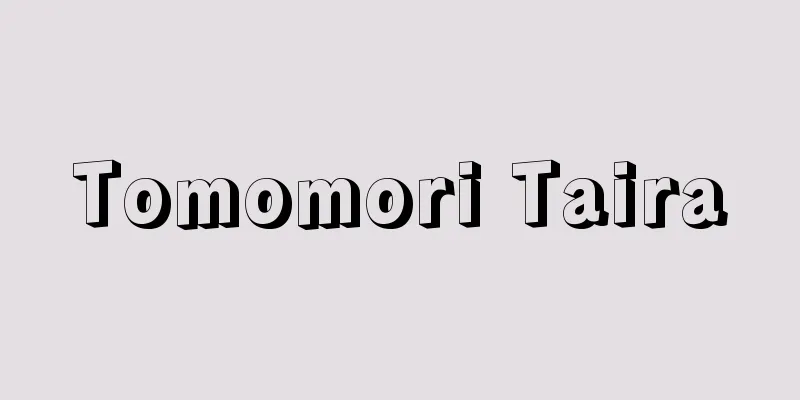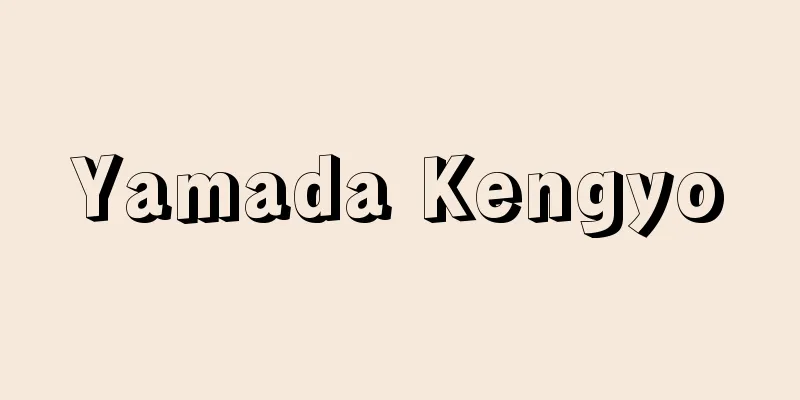Peking Opera

|
A representative form of traditional Chinese theater. Most traditional Chinese theater is in the form of opera, and there are distinctive developments in song, language, and acting style depending on the era and region, with a particular distinctive feature being that differences in melody determine the theatrical style. Peking Opera is so named because it was perfected in the Beijing region, out of the more than 360 types of traditional regional theater that can be counted. It is also called Pi Huang Opera (Pi Huang Opera) due to its melody, but is now known worldwide as Beijing Opera. [Uchiyama Uzura] historyAmong the many forms of traditional theater that have followed a rich and diverse path, the melody known as Erhuangdi, which originated in the mid-17th century (late Ming and early Qing dynasties) in areas along the Yangtze River, such as Hubei and Anhui provinces, eventually developed into Peking Opera. This combines the folk songs of Hubei and Anhui provinces with the melody of the Jiangxi region, known as Yiyangkou, but it is so named because it was created primarily by actors from Huanggang and Huangpi in Hubei province. For about 300 years, following the Yuan dynasty zaju (Yuanqu) and the Ming dynasty legends into the Qing dynasty, Kunqu (also known as Kunqu), which originated in the Kunshan region of Suzhou, dominated the throne. However, in the 18th century, Kunqu became a pastime for royalty and aristocrats and showed signs of decline, while Erhuangdiang began to flourish among the general public. This new theatre reached Yangzhou in Jiangsu Province, the commercial centre of the time, and was brought to Beijing by a wealthy local merchant at the celebration of the 80th birthday of Emperor Qianlong Gaozong in 1790. At that time, Gao Langting, a young female actor from the Sanqingban theatre troupe in Anhui Province, took the capital by storm with her performance of Erhuang Dian. In contrast to the literary and elegant but difficult and lengthy Kunju, Erhuang Dian was short in performance time, simple and full of action, and incorporated the emotions of everyday life of the common people, making it easy for the masses to accept and quickly became popular. As an emerging type of drama and stylistically flexible, Erhuang Opera eagerly adopted techniques and styles from many previous types of drama, including Kunju. Around 1830, during the late Qing Dynasty, it merged with the Xipi style, which was derived from the Qinqiang style in the Shaanxi region, to become Pihuangqiang, or Peking Opera, and replaced Kunju as the king of the theatrical world. Pi means singing, and qiang means melody. In other words, Peking Opera has a history of less than 200 years, which is relatively short for traditional Chinese drama. Although it was derided as a vulgar popular drama by upper-class intellectuals who loved the long-standing Kunju, it was reformed and its quality improved with the emergence of famous actors such as Cheng Changgen and later Tan Xinpei in the early days. During the New Culture Movement, beginning with the May Fourth Movement in 1919, Peking Opera was seen as a stronghold of old culture, but the great female actor Mei Lanfang and others attempted to modernize the theaters and performance style, and the art was further refined. There is a famous story about Mei Lanfang, who grew a beard and refused a request from the Japanese military to perform during the Second Sino-Japanese War. Mei performed in Japan three times, in 1919, 1930, and 1956, and there are many Peking Opera fans in Japan. [Uchiyama Uzura] Content and formatLike many other traditional dramas, it has a unique style that is composed of song, dialogue, gestures, and action scenes, and is often compared to Japanese Noh and Kabuki. Particular emphasis is placed on singing, and actors are called "drama singers" and theatergoers are called "listening to drama." The scripts are not considered to be highly literary compared to Yuan opera, legendary fiction, and Kun opera, and are more like performance scripts, and most of the 1,300 or so extant versions are of unknown authors. In addition to adaptations of Yuan opera and legendary fiction, there are particularly many partial adaptations of "Romance of the Three Kingdoms," and the majority of works are around an hour long and based on historical novels, myths, and legends such as "Water Margin," "Journey to the West," "Dream of the Red Chamber," and "Strange Stories from a Chinese Liaozhai." Originally, it was performed on a square stage in front of a single curtain, and the only props were a red-painted table and one or two chairs, which were piled up to represent mountains and rocks, and various small flags and cloth screens to express scenes. The accompaniment is led by a Chinese fiddle instead of the flute used in Kun Opera, and gongs and drums set the rhythm of the mie and tachimawari. There are more than 20 melodies used, but the rhythm and tempo are carefully designed according to the content. In this way, exaggeration based on conventions is sublimated into a dance-like and symbolic style of acting. The costumes are extravagant and timeless, based on the costumes of the Ming dynasty, and the colors and patterns symbolize the status and occupation of the performers. Originally, it was a stage performed only by male actors, and the development of female actors is similar to that of Kabuki, but since modern times, the number of female actors has increased. The roles are strictly defined and broadly divided into Sei (leading role), Tan (female role), Jo (hero, enemy role), Chu (clown role), and Matsu (supporting role), with Jo and Chu having makeup applied to their faces. Each role is divided into two categories, civil and military, and is further subdivided. Actors learn specialized roles suited to their qualities from an early age. Representative classic pieces of Peking opera created in this way include "The Fisherman's House," "The Space Fence," "The Legend of the White Snake," "The Lady Yangmen," "Wild Pig Forest," "Farewell My Concubine," "The Drunken Concubine," "The Three Chakou," "Yandangshan," and "The Palace of the Monk." Each piece develops a magnificent stage with its music, costumes, dance-like movements, and tense fighting scenes, creating excellent narrative expressions. The direction and acting of these pieces also inspired the German Brecht to develop his theory of narrative theater. Western critics have described the elegant, dense, and refined performances of Peking Opera as "acting that walks a fine line between death" and "movements calculated in units of one-thousandth of a second and one-hundredth of a millimeter." [Uchiyama Uzura] Reform of Peking OperaWith the founding of the People's Republic of China, the China Traditional Drama Research Institute and the China Peking Opera Theatre were the focus of a national cultural policy to promote a reform movement in traditional drama. Under the policy of "Let a hundred flowers bloom, and promote the old to produce something new," a systematic effort was made to remove feudal content from both scripts and direction in Peking Opera and to unearth the creativity of the people. This was a further step in the modernization of Peking Opera, which had been started by famous actors such as Mei Lanfang in the 1920s, and plays based on modern themes were also created in order to "pour new wine into old wineskins." However, classical plays that were originally created in a feudal society could not be performed as they were in a socialist society, and some plays were banned, and most of the plays required revision. The reorganization and reorganization of numerous classical plays and the creation of new historical plays could not keep up with the actual demand, and there were few plays that could be performed, which hindered many theater companies' performance activities and led to audiences turning away from Peking Opera. Around the time of the "Hundred Flowers Blooming/Hundred Schools Contesting" movement in 1956, plays that had once been banned were put on stage in order to attract audiences. Furthermore, the reform of traditional theater did not progress amid circumstances such as the Anti-Rightist Movement from 1957, the failure of the Great Leap Forward from 1958, three years of natural disasters from 1959, the Sino-Soviet dispute surfacing in 1960, and the death of Mei Lanfang in 1961. As a result, the government held a modern Peking opera competition in 1964, but this was led by Jiang Qing (wife of Mao Zedong). This was the fuse that ignited the Cultural Revolution. Jiang Qing and others designated eight plays, including five revolutionary modern Peking operas such as "Take the Tiger Mountain with Wisdom," "Red Lantern Legend," and "Sha Jiabang," two ballets, and one symphony, as model plays, and banned the performance of any other works, including classical plays, in a tyrannical manner that stifled not only Peking opera but the entire Chinese theater world for over ten years. In the name of revolutionizing Peking opera, modern Peking opera has adopted heroic protagonists, and has come to resemble dialogue dramas in both stage structure and acting. The Cultural Revolution ended in 1976, and the theater world soon recovered, with classical plays beginning to take to the stage again. However, many great actors passed away, and the 10-year hiatus was a major gap for the actors and musicians who were to take over from them. However, the reorganization and restructuring of classical plays continued, and new historical plays and modern Peking operas are being enthusiastically attempted. With an increasing number of performances abroad, including in Japan, Peking opera, China's representative form, is steadily on the road to recovery. In 1989, the joint performance of the China Peking Opera Company and Japan's Ichikawa Ennosuke troupe, Ryuo, was well received, demonstrating that Peking opera is still going strong, and since then Peking opera troupes from around the country have visited Japan to perform almost every year. [Uchiyama Uzura] ``Peking Opera Techo'' by Yoshio Takeuchi et al. (1956, Sanyi Shobo)'' ▽ ``Peking Opera'' by Shigetoshi Kawatake et al. (1956, Awaji Shobo)' ' ▽ ``Peking Opera Reader'' by Iwaateru Ishihara and Toshio Okazaki (1956, Asahi Shimbun)' ' ▽ ``Katsuo Hiizumi, ``Peking Opera and the Chinese'' (1995, Shinchosha)' ' ▽ ``Complete Manual for Appreciating Peking Opera'', by Zhao Xiaoqun and Kazuhiro Mukoda (1998, Kobun Publishing)' ' ▽ ``Introduction to Peking Opera'', by Daming Lu (2000, Ongaku no Tomosha)'' [References] | | | | | | | | | | | | |Legend | | | |Source: Shogakukan Encyclopedia Nipponica About Encyclopedia Nipponica Information | Legend |
|
中国の代表的な伝統演劇。中国の伝統演劇はほとんどが歌劇形式であり、時代や地域によって、歌曲、ことば、演技様式などに特徴的な発達がみられ、とくに曲調の違いが劇様式を決定するという点に特色がある。京劇は、360種以上も数えられるという伝統的な地方劇のうち、北京(ペキン)地方で大成したところからこの名があり、またその曲調から皮黄戯(ひこうぎ)ともよばれるが、いまではペキン・オペラの名でも世界に知られている。 [内山 鶉] 歴史豊富多彩な足跡をたどってきた伝統演劇のうち、17世紀中葉(明(みん)末清(しん)初)湖北(こほく/フーペイ)省、安徽(あんき/アンホイ)省など揚子江(ようすこう/ヤンツーチヤン)沿岸地域に生まれた二黄調(にこうちょう)という節回しが、やがて京劇に成長してゆく。これは、湖北、安徽両省の民謡に弋陽腔(よくようこう)とよばれる江西(こうせい/チヤンシー)省一帯の曲調が結び付いたものであるが、湖北省の黄岡(こうこう)、黄陂(こうは)出身の俳優たちを中心に編み出されたところから二黄調の名がある。元代の雑劇(元曲)、明代の伝奇の後を受けて清代に至る300年ほどは、蘇州(そしゅう/スーチョウ)の崑山(こんざん)地方におこった崑劇(こんげき)(崑曲(こんきょく)ともいう)が王座を占めていたが、18世紀に入って王侯貴族の慰みものとなり衰微の兆しをみせた崑曲に対して、民衆のなかで盛行し始めたのが二黄調であった。 この新しい演劇が、当時の商業中心地であった江蘇(こうそ/チヤンスー)省の揚州に及び、1790年乾隆帝(けんりゅうてい)高宗(こうそう)の80歳の誕生祝宴を機に、その地の豪商の手で北京にもたらされた。このとき安徽省の劇団三慶班の若手女方(おんながた)高朗亭(こうろうてい)が二黄調を演じて首都を席巻(せっけん)したのである。文学的で優雅であるが難解で冗長な崑劇に対して、上演時間は短く、平易で動きが多く、民衆の生活感情を盛り込んだ二黄調は大衆受けしやすく、たちまち流行し始めた。新興の劇種でもあり様式上の融通もきくために、二黄調は崑劇をはじめ多くの先行劇種から技術やスタイルを貪欲(どんよく)に取り入れつつ、清末の1830年ごろには、陝西(せんせい/シャンシー)地方の秦腔(しんこう)の流れをくむ西皮(せいひ)という曲調と合体することによって、皮黄腔つまり京劇へと飛躍を遂げ、崑劇にとってかわって劇界の覇者となるに至った。皮は歌うことを意味し、腔は節回しのことである。つまり、京劇の歴史はたかだか200年たらず、中国の伝統劇としては比較的浅いものであり、歴史の長い崑劇を愛好する上流知識人からは低俗な大衆劇とさげすまれながらも、草創期に程長庚(ていちょうこう)、のちに譚鑫培(たんきんばい)らの名優が輩出して改革を重ね、格調を高めてきた。 1919年の五・四運動をはじめとする新文化運動のなかでは、京劇は旧文化の牙城(がじょう)ともされたが、女方の名優梅蘭芳(メイランファン)らによって、劇場や上演形式の近代化が試みられ、芸にもいっそうの磨きがかけられた。日中戦争時にひげを蓄えて日本軍の上演要請を拒否したという梅蘭芳のエピソードは有名である。梅は1919年、30年、56年と三たび日本公演を行っており、日本にも京劇愛好者は少なくない。 [内山 鶉] 内容と形式他の多くの伝統劇種と同じく、歌、せりふ、しぐさ、立回りによって構成される独特の様式をもち、しばしば日本の能や歌舞伎(かぶき)に比せられる。とくに歌唱が重視され、俳優のことを「劇歌い」、観劇のことを「聴劇」ともいう。脚本は元曲、伝奇、崑劇などに比べて文学性が高いとはいえず、むしろ上演用の台本というべきで、現存の1300余種のほとんどが作者不詳である。元曲や伝奇の改作のほか、『三国志』の部分脚色がとくに多く、『水滸伝(すいこでん)』『西遊記』『紅楼夢(こうろうむ)』『聊斎志異(りょうさいしい)』など史伝小説、神話伝説に取材した1時間前後の作品が大半を占めている。 もともと1枚の幕の前の方形の舞台で上演され、道具は紅塗りの机と椅子(いす)1、2脚のみ、それを積み上げて山や岩を表したり、各種の小旗や布屏風(びょうぶ)で場面を表現する。伴奏音楽は、崑劇の笛にかわって胡弓(こきゅう)が歌のメロディを主導し、銅鑼(どら)や太鼓が見得(みえ)や立回りのリズムを刻む。使用されるメロディは20曲余りであるが、内容に応じてリズム、テンポのくふうが凝らされる。このように約束ごとに基づく誇張が、舞踊的また象徴的な様式演技に昇華されるのである。衣装は明代の装束をもとにした超時代的な華美なもので、色や模様で身分や職業が象徴される。もともとは男優のみで演じられる舞台で、女方の発達は歌舞伎にも似ているが、近代以降は女優も多くなっている。役柄は厳密に定められ、大きくは、生(せい)(立役)、旦(たん)(女方)、浄(じょう)(豪傑、敵(かたき)役)、丑(ちゅう)(道化役)、末(まつ)(端役)に分かれて、浄と丑は顔に隈取(くまどり)(臉譜(れんぷ))をする。それぞれの役柄に文武の2系統があるほか、さらに細分化されている。俳優は幼少時から資質にあった専門の役柄を習得するのである。 こうしてつくられた京劇の代表的な古典演目には『打漁殺家(だぎょさっか)』『宇宙鋒(うちゅうほう)』『白蛇伝(はくじゃでん)』『楊門女将(ようもんじょしょう)』『野猪林(やちょりん)』『覇王別姫(はおうべっき)』『貴妃酔酒(きひすいしゅ)』『三岔口(さんたこう)』『雁蕩山(がんとうざん)』『鬧天宮(どうてんきゅう)』などがある。いずれもその音楽、衣装、舞踊的動作、緊迫した立回りなどによって絢爛(けんらん)たる舞台を展開し、優れて叙事的な表現を生み出す。その演出・演技は、ドイツのブレヒトが叙事演劇論を編み出すヒントにもなった。格調高く密度の濃い、研ぎ澄まされた京劇の舞台を、西欧の批評家は「死と紙一重の演技」や「1000分の1秒の時間と100分の1ミリの空間を単位として計算された動作」などと評している。 [内山 鶉] 京劇改革新中国の成立とともにつくられた中国伝統劇研究院や中国京劇院を中心に、国家の文化政策として伝統劇の改革運動が推進された。「百花斉放(ひゃっかせいほう)、陳(ふる)きを推して新しきを出す」という方針のもとに、京劇についても、脚本、演出の両面から封建的な内容を取り除き、民衆の創造にかかるものを掘り起こす作業が組織的に行われたが、これは、1920年代から梅蘭芳ら名優の手によって始められた京劇の近代化をさらに進めるもので、「古き革袋に新しき酒を盛る」ために現代を題材とする演目も創作された。しかし、もともと封建社会のなかで生まれた古典演目が、社会主義社会でそのまま上演できるわけもなく、上演禁止演目も出てくるし、ほとんどが改訂を要することになる。数多くの古典演目の整理改編や新作歴史劇の創作は実際の需要に追いつかず、上演できる演目が少なくて、多くの劇団が公演活動に支障をきたし、観客の京劇ばなれも起こってきた。1956年の「百花斉放・百家争鳴運動」のころから観客を呼ぶために一度は上演を禁止された演目までが舞台にかけられるようになる。さらに57年からの反右派闘争、58年からの大躍進政策の失敗、59年から3年にわたる自然災害、60年の中ソ論争表面化、そして61年には梅蘭芳の死去という情勢のなかで、伝統劇の改革は進まなかった。そこで政府は64年に現代京劇競演大会を開いたが、それは江青(こうせい/チヤンチン)(毛沢東夫人)の主導によるものだった。これが文化大革命の導火線となったのである。江青らは、『智取威虎山(ちしゅいこざん)』『紅灯記』『沙家浜(さかほう)』など革命現代京劇5本、バレエ2本、交響曲1本の8演目を模範劇とし、古典演目など他作品の上演をいっさい禁止するという暴政に出て、京劇のみならず中国演劇界全体に10年余に及ぶ窒息状態をもたらした。現代京劇は、京劇革命化の名のもとに英雄を主人公とし、舞台構成、演技ともに対話劇に大きく近づける結果になってしまった。 1976年にはいわゆる文化大革命も終結、やがて演劇界は息を吹き返し、古典演目も舞台をにぎわし始めたが、名優たちは相次いで故人となり、そのあとを継ぐべき俳優や楽士たちにとっても空白の10余年間は大きかったといわざるをえない。しかしその後も、古典演目の整理改編は続けられ、新作歴史劇や現代京劇も意欲的に試みられている。日本をはじめ国外公演も増えて、中国を代表する京劇は着実に再興への道を歩んでいる。89年には中国京劇院と日本の市川猿之助一座との合同公演『リュウオー』が好評を博して京劇の健在ぶりを示したし、その後はほとんど毎年のように各地の京劇団が訪日公演を行っている。 [内山 鶉] 『竹内良男他著『京劇手帖』(1956・三一書房)』▽『河竹繁俊他著『京劇』(1956・淡路書房)』▽『石原巌徹・岡崎俊夫著『京劇読本』(1956・朝日新聞社)』▽『樋泉克夫著『京劇と中国人』(1995・新潮社)』▽『趙暁群・向田和弘著『京劇鑑賞完全マニュアル』(1998・好文出版)』▽『魯大鳴著『京劇入門』(2000・音楽之友社)』 [参照項目] | | | | | | | | | | | | | | | | | |出典 小学館 日本大百科全書(ニッポニカ)日本大百科全書(ニッポニカ)について 情報 | 凡例 |
<<: (■1) Kyou-kechi (Kyou-kechi)
Recommend
Pilgrimage to Izumi - Ka-me
...It is said that the god of fire in the hearth ...
Ogi [town] - Ogi
An old town in Ogi County, central Saga Prefecture...
Rochow, EG
...Industrially important fluorine compounds such...
Tilburg - Tilburg (English spelling)
A city in the central part of the province of Noo...
Economic geography (English spelling)
An academic field that uses geographical methods ...
Ogata [town] - Ogata
An old town in Hata District facing Tosa Bay in th...
Tang Dynasty Reports - Toufu Setsugaki
Information from overseas brought by Qing merchant...
Futhark
…The linear and sharp-angled form of runes is tho...
l-ephedrine
… [Medicinal] In addition to Chinese Ephedra, the...
Ultimate weapon
The term came into use around the end of the 1950s...
terre à terre (English spelling) terraterre
The term "terre à terre" also refers to...
Kyosho (Era name)
...Then, in 84 (Genchu 1, Shitoku 1), the Kōtok...
Crossing - Crossing
〘noun〙① Something that passes from one place to an...
Marsia
…Anis was a poet active during the reign of the I...
Joseph Roumanille
1818‐91 A modern poet and writer of Provencal (Occ...









![Uenohara [town] - Uenohara](/upload/images/67cafa24615c8.webp)